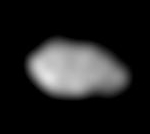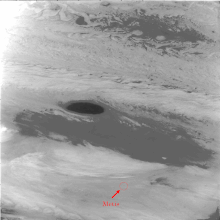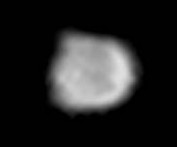Metis (moon)
 Image taken byGalileo'sSolid State Imagerbetween November 1996 and June 1997 | |
| Discovery | |
|---|---|
| Discovered by | S. Synnott |
| Discovery date | 4 March 1979 |
| Designations | |
| Pronunciation | /ˈmiːtəs/[1] |
Named after | ΜήτιςMētis |
| Adjectives | Metidian, Metidean/mɛˈtɪdiən/ |
| Orbital characteristics | |
| Periapsis | 127974km[a] |
| Apoapsis | 128026km[a] |
Mean orbitradius | 128000km(1.792 RJ)[2][3] |
| Eccentricity | 0.0002[2][3] |
| 0.294780d(7 h, 4.5 min)[2][3] | |
Averageorbital speed | 31.501 km/s[a] |
| Inclination | 0.06° (to Jupiter's equator)[2][3] |
| Satellite of | Jupiter |
| Physical characteristics[4] | |
| Dimensions | 60 km × 40 km × 34 km |
| 21.5±2.0 km | |
| ≈ 6200 km2[a] | |
| Volume | ≈ 42700km3[a] |
| Mass | ≥6.4×1016kg[a] |
Meandensity | ≥1.5 g/cm3 |
| ≥0.8 cm/s2(average) | |
| synchronous | |
| zero | |
| Albedo | 0.061±0.003[5] |
| Temperature | ≈ 123 K |
Metis/ˈmiːtəs/,also known asJupiter XVI,is theinnermostknownmoon of Jupiter.It was discovered in 1979 in images taken byVoyager 1,and was named in 1983 after the first wife ofZeus,Metis.Additional observations made between early 1996 and September 2003 by theGalileospacecraftallowed its surface to be imaged.
Metis istidally lockedtoJupiter,and its shape is strongly asymmetrical, with the largest diameter being almost twice as large as the smallest one. It is also one of the two moons known to orbit Jupiter in less than the length of Jupiter's day, the other beingAdrastea.It orbits within themain ring of Jupiter,and is thought to be a major contributor of ring material.
Discovery and observations[edit]

Metis was discovered in 1979 byStephen P. Synnottin images taken by theVoyager 1probe and wasprovisionally designatedasS/1979 J 3.[6][7]In 1983, it was officially named after the mythologicalMetis,aTitanesswho was the first wife ofZeus(theGreek equivalentofJupiter).[8]The photographs taken byVoyager 1showed Metis only as a dot, and hence knowledge about Metis was very limited until the arrival of theGalileospacecraft.Galileoimaged almost all of the surface of Metis and put constraints on its composition by 1998.[4]
Although theJunoorbiter, which arrived at Jupiter in 2016, has a camera calledJunoCam,it is almost entirely focused on observations of Jupiter itself. During close observations of Jupiter, it may capture some distant images of the innermost moons Metis andAdrastea.[9]
Physical characteristics[edit]

Metis has an irregular shape and measures60 km × 40 km × 34 kmacross, which makes it the second smallest of the fourinner satellites of Jupiter.[4]Therefore, a very rough estimate of its surface area could be placed between 5,800 and 11,600 square kilometers (approx. 8,700).[citation needed]The bulk composition and mass of Metis are not known, but it is likely that its mean density is 1.5 g/cm3or higher,[10]and its mass can therefore be estimated as ~6.4×1016kg or higher.
The surface of Metis is heavily cratered, dark, and appears to be reddish in color. There is a substantial asymmetry between the leading and trailinghemispheres:the leading hemisphere is 1.3 times brighter than the trailing one. The asymmetry is probably caused by the higher velocity and frequency of impacts on the leading hemisphere, which excavates a bright material (presumably ice) from its interior.[5]
Orbit and rotation[edit]
Metis is the innermost of Jupiter's four smallinner moons.It orbits Jupiter at a distance of ~128,000 km (1.79 Jupiter radii) within Jupiter'smain ring.Metis's orbit has very smalleccentricity(~0.0002) andinclination(~ 0.06°) relative to the equator of Jupiter.[2][3]
Due totidal locking,Metis rotates synchronously with its orbital period (about 7 hours), with its longest axis aligned towards Jupiter.[3][4]Jupiter casts a shadow on all of Metis for 68 minutes each Metian day.[a]
Metis lies inside Jupiter'ssynchronous orbitradius (as doesAdrastea), and as a result,tidal forcesslowly cause its orbit to decay. If its density is similar to Amalthea's, Metis's orbit lies within the fluidRoche limit;however, because it has not broken up, it must lie outside its rigid Roche limit.[3]
Relationship with Jupiter's rings[edit]

Metis's orbit lies ~1,000 km within the main ring of Jupiter. It orbits within a ~500 km wide "gap" or "notch" in the ring.[3][11]The gap is clearly somehow related to the moon but the origin of this connection has not been established. Metis supplies a significant part of the main ring's dust.[12]This material appears to consist primarily of material that is ejected from the surfaces ofJupiter's four small inner satellitesby meteorite impacts. It is easy for the impact ejecta to be lost from the satellites into space because the satellites' surfaces lie fairly close to the edge of theirRoche spheresdue to their low density.[3]
See also[edit]
Notes[edit]
References[edit]
Citations[edit]
- ^Noah Webster (188).A Practical Dictionary of the English Language.
- ^abcdeEvans Porco et al. 2002.
- ^abcdefghiBurns Simonelli et al. 2004.
- ^abcdThomas Burns et al. 1998.
- ^abSimonelli Rossier et al. 2000.
- ^IAUC 3507.
- ^Synnott 1981.
- ^IAUC 3872.
- ^Hansen, C. J.; Orton, G. S. (2015)."JunoCam: Science and Outreach Opportunities with Juno".AGU Fall Meeting Abstracts.2015:P41B–2066.Bibcode:2015AGUFM.P41B2066H.
- ^Anderson Johnson et al. 2005.
- ^Ockert-Bell Burns et al. 1999.
- ^Burns Showalter et al. 1999.
Sources[edit]
- Anderson, J. D.; Johnson, T. V.; Schubert, G.; Asmar, S.; Jacobson, R. A.; Johnston, D.; Lau, E. L.; Lewis, G.; Moore, W. B.; Taylor, A.; Thomas, P. C.; Weinwurm, G. (27 May 2005). "Amalthea's Density is Less Than That of Water".Science.308(5726): 1291–1293.Bibcode:2005Sci...308.1291A.doi:10.1126/science.1110422.PMID15919987.S2CID924257.
- Burns, Joseph A.; Showalter, Mark R.; Hamilton, Douglas P.; Nicholson, Philip D.; de Pater, Imke; Ockert-Bell, Maureen E.; Thomas, Peter C. (14 May 1999)."The Formation of Jupiter's Faint Rings"(PDF).Science.284(5417): 1146–1150.Bibcode:1999Sci...284.1146B.doi:10.1126/science.284.5417.1146.PMID10325220.S2CID21272762.Archived fromthe original(PDF)on 5 December 2020.
- Burns, Joseph A.; Simonelli, Damon P.; Showalter, Mark R.; Hamilton, Douglas P.; Porco, Carolyn C.; Throop, Henry; Esposito, Larry W. (2004)."Jupiter's Ring-Moon System"(PDF).In Bagenal, Fran; Dowling, Timothy E.; McKinnon, William B. (eds.).Jupiter: The Planet, Satellites and Magnetosphere.Cambridge University Press. pp. 241–262.Bibcode:2004jpsm.book..241B.ISBN978-0-521-81808-7.
- Evans, M. W.; Porco, C. C.; Hamilton, D. P. (September 2002). "The Orbits of Metis and Adrastea: The Origin and Significance of their Inclinations".Bulletin of the American Astronomical Society.34:883.Bibcode:2002DPS....34.2403E.
- Marsden, Brian G. (August 26, 1980)."Satellites of Jupiter".IAU Circular.3507.Retrieved2012-03-28.(discovery)
- Marsden, Brian G. (September 30, 1983)."Satellites of Jupiter and Saturn".IAU Circular.3872.Retrieved2012-03-28.(naming the moon)
- Ockert-Bell, M. E.; Burns, J. A.; Daubar, I. J.; Thomas, P. C.; Veverka, J.; Belton, M. J. S.; Klaasen, K. P. (1 April 1999)."The Structure of Jupiter's Ring System as Revealed by the Galileo Imaging Experiment".Icarus.138(2): 188–213.Bibcode:1999Icar..138..188O.doi:10.1006/icar.1998.6072.
- Simonelli, D. P.; Rossier, L.; Thomas, P. C.; Veverka, J.; Burns, J. A.; Belton, M. J. S. (October 2000)."Leading/Trailing Albedo Asymmetries of Thebe, Amalthea, and Metis".Icarus.147(2): 353–365.Bibcode:2000Icar..147..353S.doi:10.1006/icar.2000.6474.
- Synnott, S. P. (19 June 1981). "1979J3: Discovery of a Previously Unknown Satellite of Jupiter".Science.212(4501): 1392.Bibcode:1981Sci...212.1392S.doi:10.1126/science.212.4501.1392.ISSN0036-8075.PMID17746259.
- Thomas, P. C.; Burns, J. A.; Rossier, L.; Simonelli, D.; Veverka, J.; Chapman, C. R.; Klaasen, K.; Johnson, T. V.; Belton, M. J. S.; Galileo Solid State Imaging Team (September 1998)."The Small Inner Satellites of Jupiter".Icarus.135(1): 360–371.Bibcode:1998Icar..135..360T.doi:10.1006/icar.1998.5976.
External links[edit]
